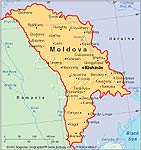This
naturally favorable land was populated since Paleolithic epoch.
From archeological excavations we know that there were living
people 7000 years BC on this territory. You can find the proof in
a very interesting archeological museum in Chisinau city.
Today Moldova occupies most of what has been known as Bess Arabia,
which represents less of the half of the historical Moldova. For
many centuries Moldova was the victim of frequent warfare. The
main reason was because Moldova's important location - a historic
passageway between Asia and Europe. Romans, Huns, Tatars, Turks,
Hungarians, Germans and many others passed through that land known
as "The Gate" between the Carpathians and the Black Sea, which in
the 13th century became part of the Mongol Empire. Moldova emerged
as an independent state in the 14th century. The first document
referring to the "Land of Moldova" dates back to 1359 AD. In 1391
AD, the ethnic group "Moldova's" was mentioned for the first time.
 The peak
time in the formation of the medieval Moldovan state - situated
between the Carpathians, the Danube and the Black Sea - was the
rule of Stefan III (1457-1504 AD). He was also called Stefan the
Great and Saint and defended the sovereignty of Moldova in battles
with Turkish Janissaries, Hungarian and Polish royal troops and
Crimea Khans. During his rule no other nation could seize Moldova.
He was known as a good diplomat and warrior. Other countries
governors said that Stefan III was brave in wars and modest in
good fortune. He had 47 battles and built 47 churches on those
places as a memory. Stefan the Great is real national hero in
Republic of Moldova.
The peak
time in the formation of the medieval Moldovan state - situated
between the Carpathians, the Danube and the Black Sea - was the
rule of Stefan III (1457-1504 AD). He was also called Stefan the
Great and Saint and defended the sovereignty of Moldova in battles
with Turkish Janissaries, Hungarian and Polish royal troops and
Crimea Khans. During his rule no other nation could seize Moldova.
He was known as a good diplomat and warrior. Other countries
governors said that Stefan III was brave in wars and modest in
good fortune. He had 47 battles and built 47 churches on those
places as a memory. Stefan the Great is real national hero in
Republic of Moldova.
In the 16th century, Ottoman Empire conquered the Moldova State.
The Turkish yoke lasted for almost 300 years.
After the Russo-Turkish War of 1806-12, the eastern half of
Moldova (Bess Arabia) between the Prut and the Dniester Rivers was
ceded to Russia, while today's Romanian Moldova (west of the Prut)
remained with the Turks. Romania, which gained independence in
1878, took control of the Russian half of Moldova in 1918. The
Soviet Union never recognized the seizure and in 1924 created an
autonomous Moldavian republic on the East Side of the Dniester
River as part of the Soviet Ukraine, USSR.
In August 1940, the Moldovan Soviet Socialist Republic was
declared a member of Soviet Union. But during World War II, for
several years the territory of the republic formed part of
Romania. After the war this land became again part of the Soviet
Union. The soviet administration decided to give the southern and
northern parts to Ukraine and Transdniestria to present Moldova.
During the 1950's many Russian teachers, doctors, engineers have
been brought to Moldova, Latin alphabet been changed into the
Cyrillic one.
In late 80s in Moldova began the national liberation movements.
The proclamation of the Moldovan language as the official language
was on August 31, 1989. On August 27, 1991, the Republic of
Moldova gained its independence and became sovereign state.
Independence did not come without its drawbacks. As a result,
Moldova has faced two ethnic conflicts and the short but bloody
civil war of 1992. Moldova's internal struggle began when the
ethnic Russian minority on the eastern side of the Dniester River
rose up against the government. The aria to the left from the
river Dniester has declared itself an autonomous state: the "Trans-Dniester
Republic", which was not recognized by any other country in the
world. This little sliver of land is one of the last places in the
world that practices a pure Stalinist form of government. It is
like stepping back in time to the years prior to perestroika and
glasnost.

Political system
During its ten years of independency Moldova government has
changed several times. The Republic has become member of the
United Nations in March 2, 1992. In August of 1994 parliament
passes a new Constitution of the Republic of Moldova that granted
substantial autonomy to Transdniestria and the "Gagauz Republic",
while reasserting Moldovan national identity and sovereignty. In
July 1995 Moldova was admitted to the Council for Europe, being
the first CIS country which admission was offered. On July 1, 1998
was adopted the Agreement for Partnership and Cooperation between
the Republic of Moldova and the European Union. In 2001 Moldova
became member of the World Trade Organization.
This small country faces many problems on the road to democracy
and free market economy, but as any other change needs adjustment,
Republic of Moldova will learn to overcome the barriers to its
stable growth.